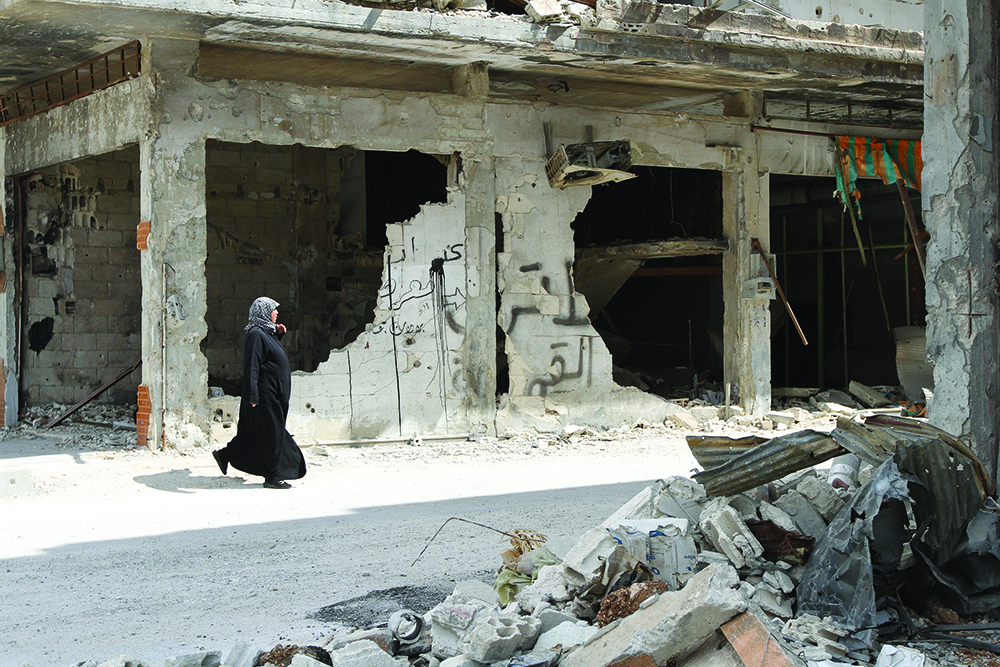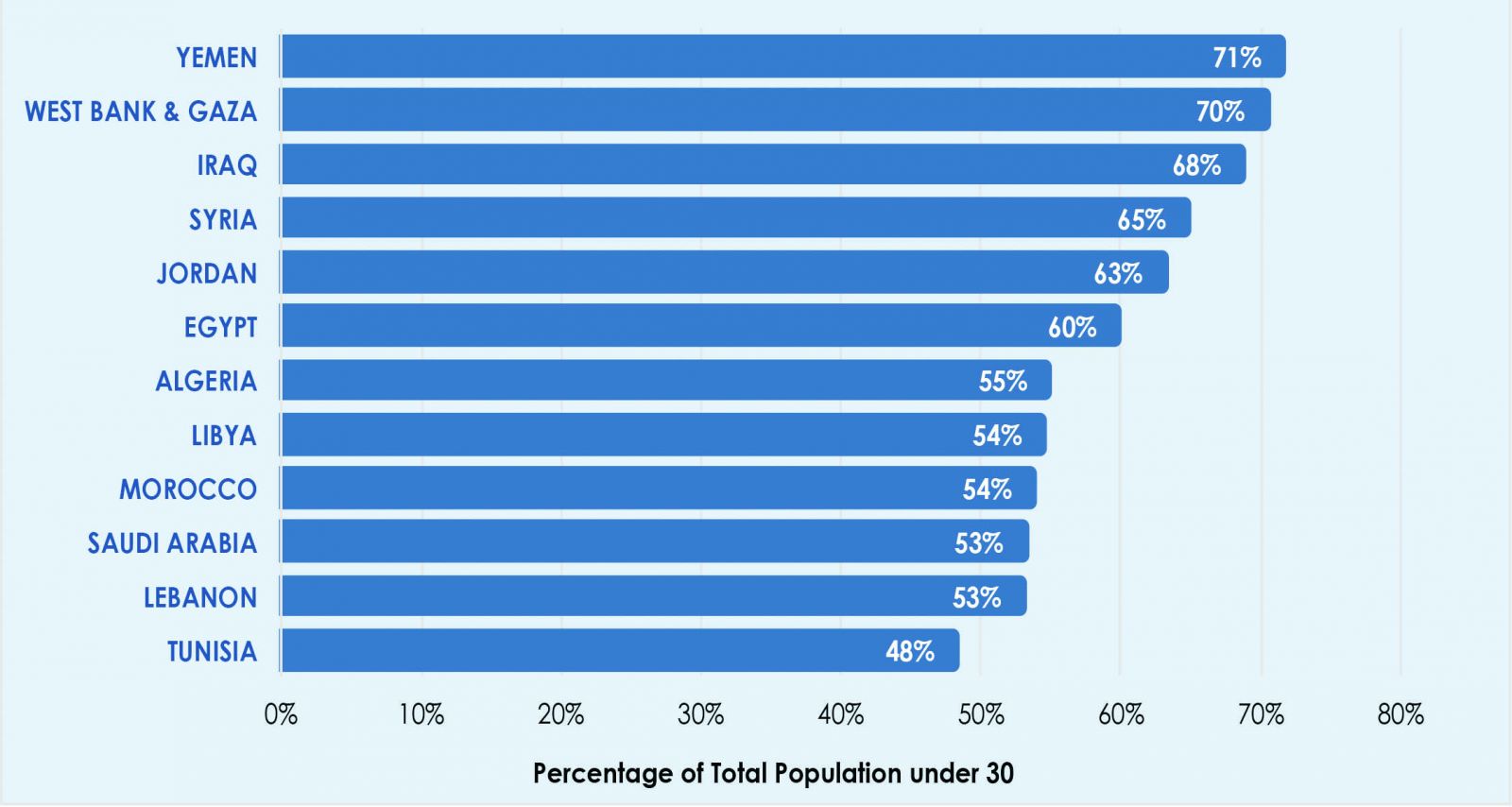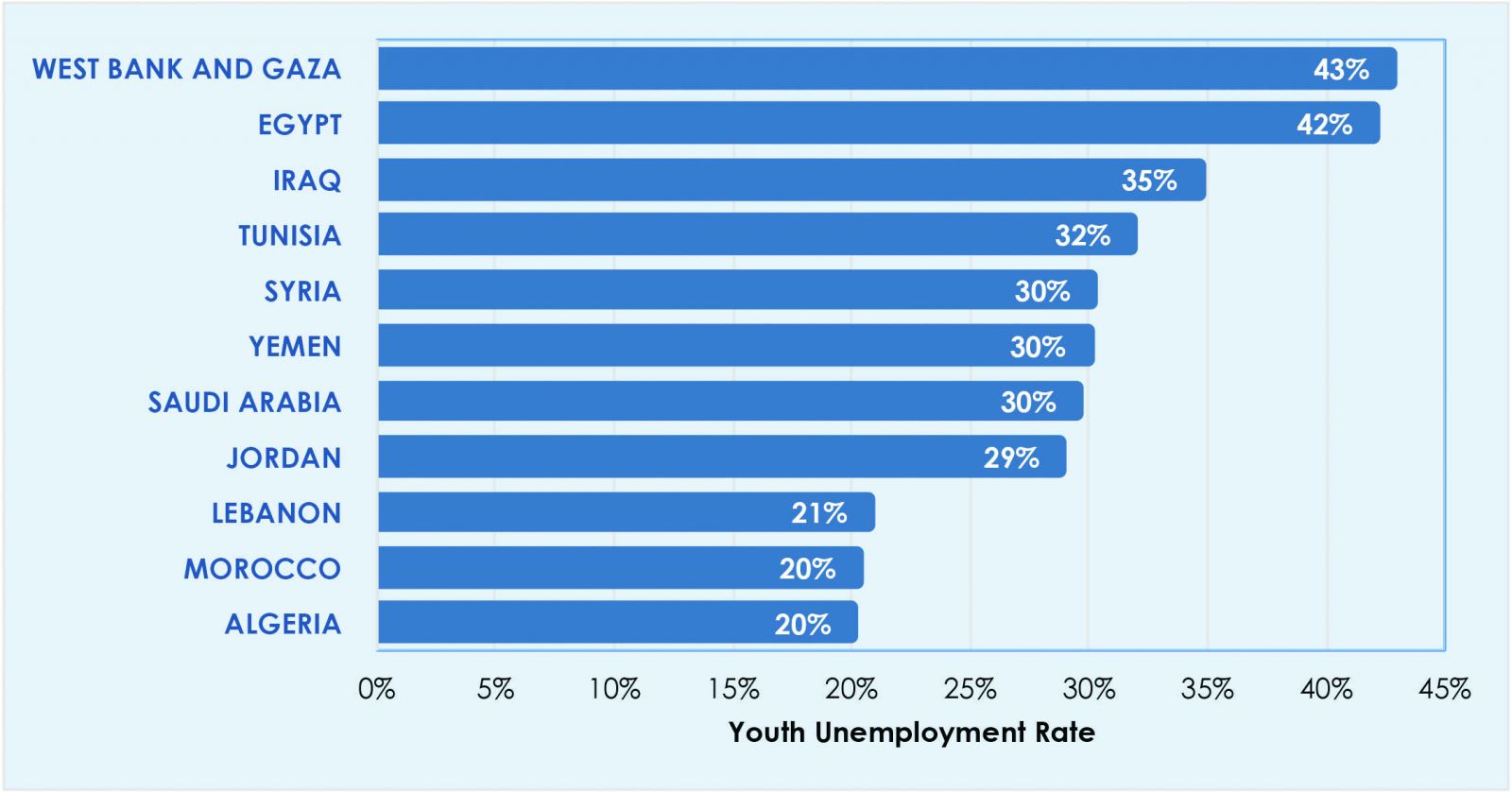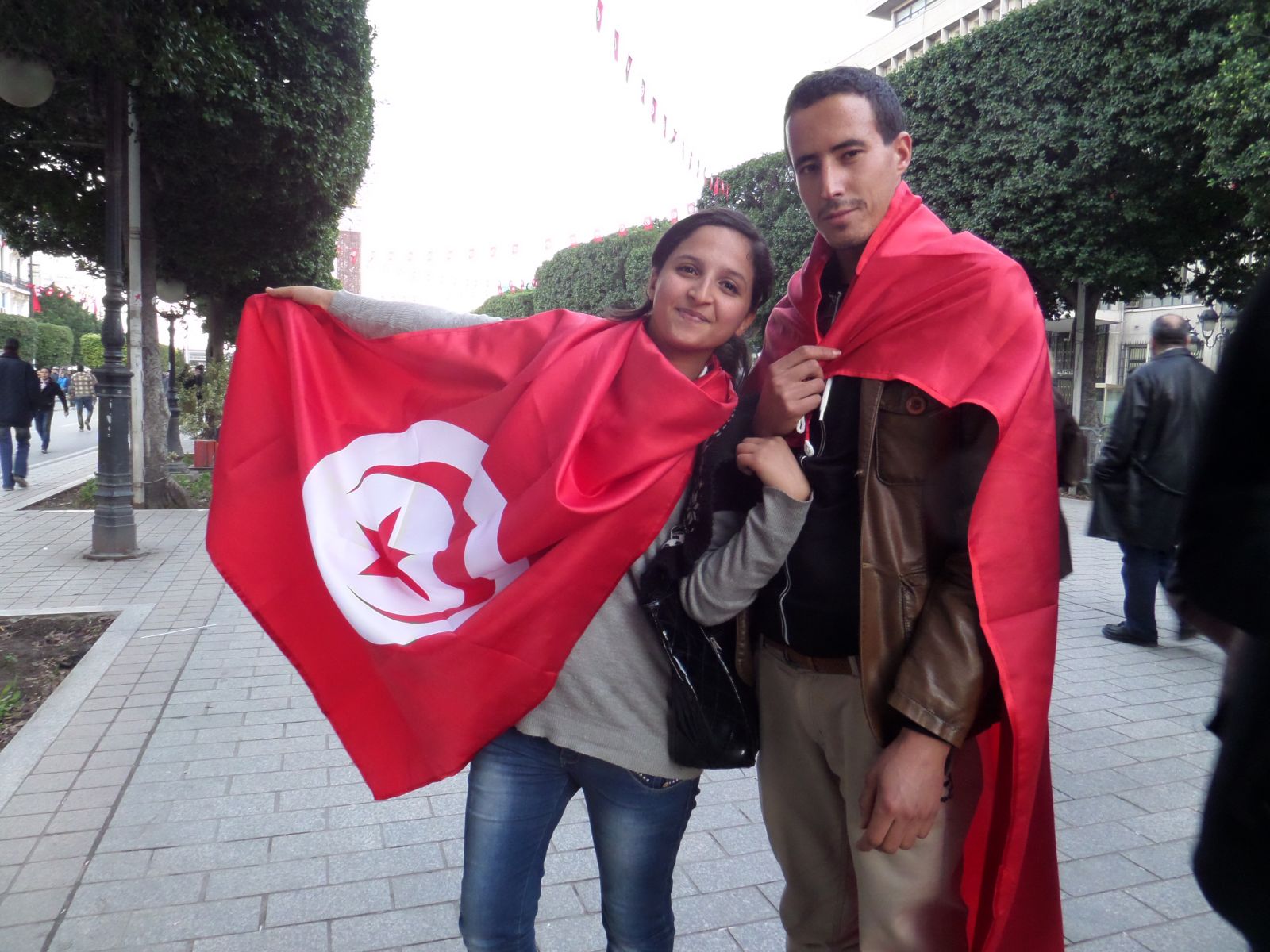The Jihadi Threat 5: Drivers of Extremism
Jihadism has always been produced by a confluence of factors. Some individuals are motivated to join jihadist movements by ideology, the desire for meaning and belonging, anger at the West, even wanderlust. Other conditions enable jihadism to flourish. They include the volatile mix of shifting demographics, notably a surge of youth, higher literacy, and greater social aspirations intersecting with economic woes, growing unemployment, and deepening political malaise or disillusionment. The mix of personal motives and enabling conditions has become even more combustible since the Arab uprisings of 2011. These drivers of extremism are rampant in the Middle East. They differ in local contexts. Six enabling conditions are particularly pivotal today.

The Frailty of States
The first condition driving jihadism is the frailty of states across the Middle East and North Africa. Many states are weaker than they were six years ago. Four have either collapsed or come close. Others are so frayed that their long-term sustainability is in doubt. The challenges are less over democracy than over the state’s ability to deliver basic services, measured by factors such as infant mortality rates, the length of time the electricity stays on, levels of available education, and jobs.
In the early twenty-first century, bad governance is widespread in the region; rampant instability has allowed extremist movements to embed politically and then exploit physically. The correlation is evident in the 2016 Fragile States Index: the four countries that deteriorated the most over the previous decade were Libya, Syria, Mali, and Yemen.46
Since the Arab uprisings in 2011, extremist groups such al-Qaeda and ISIS have exploited the failure of traditional states to advance their agendas. As nation-states fray, people across the region are retreating to more basic forms of identity, including sect, ethnicity, or tribe. Religious and sectarian discourse is central to the jihadi narrative. Extremist groups have presented themselves as the Sunni vanguard (or protectors) against Shiites, Alawites, Christians, and Jews.
In desperation, some countries have ceded control of governance or security to groups that do not necessarily serve long-term national interests, as Baghdad did in tapping both tribes and militias to provide security. Regionwide, similar trends have produced unintended consequences. The result has often been the rise of a political periphery, which is more dynamic or energetic than traditional centers of power in Damascus, Baghdad, or Cairo. Over the next decade, groups operating on the periphery could become even more important.
Traditional Arab powers face their own internal crises, which jihadis may try to exploit to challenge regimes, redefine the regional order, and grow their ranks. Virtually every type of government—including the new democracy in Tunisia, the military-based government in Egypt, the fragile republic in Iraq, and dynastic rule in the Gulf—is vulnerable. Two governments—in Saudi Arabia and Egypt—exemplify the dangers.

ISIS’s Rumiyah magazine on Islamic law. Image from Al-Hayat Media Center.
Saudi Arabia, the birthplace of Islam, is going through an awkward transition, politically and economically, compounded by a costly war in Yemen. In the face of low oil prices, Riyadh is trying to transition away from a rentier economy, which accounts for 92 percent of revenues, under its ambitious “Vision 2030” reform plan.47 The government is attempting to curtail its expensive cradle-to-grave welfare system at a time when 30 percent of its young are unemployed and two-thirds of its population is under 30.48
Young Saudis have contributed large numbers to all three generations of jihadis—at least 2,500 to the Islamic State and other violent extremist groups in Iraq and Syria, the second-largest number after Tunisia. The kingdom has also long been a patron of more fragile Arab countries; but its woes may limit its largesse and impact allies.

ISIS’s Rumiyah magazine on Islamic law. Image from Al-Hayat Media Center.
Egypt accounts for one-quarter of the Arab world’s almost 400 million people. It is a political trendsetter for the region. But it too suffers from a youth bulge and deepening economic woes after the Tahrir Square uprising in 2011, a military coup, and the election of former field marshal Abdel Fattah el Sisi as president in 2014.
Nearly a third of Egypt’s youth is unemployed; some 60 percent of its 94 million people are under 30 years old.49 Social unrest is mounting. Egypt was shaken by more than 1,100 labor protests last year.50 It witnessed 500 more in the first four months of 2016.51 Egypt has spawned key ideologues, such as Sayyid Qutb, and extremist movements, from Islamic Jihad in the 1980s and 1990s to Sinai Province today.
Egyptians have figured in all three generations of jihadis. The mastermind of the 9/11 attacks, Mohamed Atta, was Egyptian. Al-Qaeda is now headed by an Egyptian physician. For almost six years, Egyptian Abu Hamza al-Muhajir was the deputy in early iterations of the Islamic State. Up to a thousand Egyptians have joined the jihad in Iraq and Syria; another thousand are estimated to be members of the Sinai Province, a branch of ISIS. Egyptians also fought with branches of the Islamic State and al-Qaeda in neighboring Libya.
Ideological Upheaval
The second condition enabling jihadism is a deep ideological upheaval. Opposition across the region has been defined more and more by religion because of the failure of autocratic regimes and secular ideologies, from Arab nationalism to the Baathist socialism of Syria and Iraq. Jihadism, with its utopian goals, is an alternative—even for those who are not particularly religious.
Salafism became one of the most dynamic currents in the Middle East. The fastest-moving current is “jihadi Salafism” (al-Salafiyya al-Jihadiyya), a hybrid that married Salafism with military jihad by nonstate actors. Salafism preaches a return to the way of life in the seventh century, when the faith was founded, and emulation of the first three generations of Muslims (the Salaf, or pious predecessors of today’s Muslims). It is defined by intolerance of competing theological formulations, such as Shiism.
Saudi Arabia has been the heartland of Salafism, in the form of what is often today called Wahhabism. Many Salafis were traditionally “quietist”—meaning they skirted mainstream politics, although Wahhabism in the eighteenth century offered precedents for modern-day jihadi violence.
Jihadi Salafism took form in the 1990s, when a Saudi version of Salafism merged with the revolutionary and jihad-oriented ideology from Egypt that is associated with the late Sayyid Qutb and his radical heirs. The result is a movement that puts a premium on the political requirement of jihad and the theological purity of Salafism.
Jihadism is about using precepts of the faith to fight for a utopian Islamic state on earth. Jihadism is part of the broader Islamist trend, but it is distinguished by its firm belief that violence is the only way to establish that utopian state. Jihadi Salafism is now more energetic than Islamism. It has also challenged traditional Islamic authority in ways that conservatives at Al-Azhar University, one of the oldest institutions of learning in the Muslim world, have not.
Two broad categories of people join ISIS, al-Qaeda, and their affiliates: One group includes religious radicals who adhere to jihadi ideologies and narratives. They have been part of the fluid jihadi Salafist movement. The other includes people who may not fully subscribe to a puritanical religious ideology but nonetheless believe in the political elements of that ideology. Their motives are often to repel regional and international influence. To them, the Muslim Brotherhood has failed; they believe peaceful forms of political Islam—or efforts to work within systems—have failed too.
In the future, jihadi Salafism is likely to increasingly draw Sunnis who feel victimized, marginalized, underrepresented, or excluded. Its promises are utopian; its supranational vision circumvents both formal structures like central governments and traditional identities like tribe, clan, or town. It fosters the illusion of an “imagined community” that will create a new homeland for people who have suffered displacement, dislocation, disillusionment, or discrimination. Its absolutist outlook and angry defiance virtually ensure confrontation and militancy. Its claim to an authentic and originalist narrative make it more compelling and more flexible in adapting to future conditions, complicating efforts to counter it.
Conflict Zones
A third enabling condition of jihadism is an environment with preexisting violence. There is a synergy between jihadism and violence, whether perpetrated by repressive regimes, militia rivalries, terrorist groups, sectarian differences, tribal tensions, criminal organizations, or foreign intervention. Jihadism exploits local tensions; it fuels and is in turned fueled by these tensions.
Violence can foster the rise of extremist groups by radicalizing organizations and individuals exposed to it. Jihadism tends to surge during periods of political tension or violence. The emergence of strong jihadist movements, whether the Islamic State or al-Qaeda, is therefore usually predictable.
 |
|
Destruction in Homs, Syria. Photograph by bwb- studio, iStock by Getty Images. |
There are abundant examples where war zones provided jihadi groups with permissive environments to proselytize and recruit: Afghanistan in the 1980s; Algeria, Bosnia, and Chechnya in the 1990s; Iraq, Somalia, and Yemen in the 2000s; Syria, Libya, and Mali today. Conflict also tends to marginalize moderate political alternatives; polarization gives jihadists an advantage.
In Syria, the rise of jihadist organizations was predictable given its history. Islamist groups have opposed the Syrian government for half a century, since the rise of the secular Baath Party in 1963 and the Assad dynasty in 1970. Most Islamist opposition was banned, often brutally; in 1982 tens of thousands of Muslim Brotherhood activists were massacred in Hama. Syria was ripe for the emergence of jihadist groups following the 2011 Arab uprising; the war in neighboring Iraq facilitated their development.
The government's reaction to the protests encouraged and accelerated the growth of jihadism. As a 2016 International Crisis Group report concluded, its response included “deliberate radicalization of the crisis through cruel, publicized violence; divisive sectarian discourse, pitting the ruling Alawite and other minorities against the Sunni majority; escalating collective punishment that destroyed cities and helped displace millions; and [the] release of jailed radicals and targeting of more pragmatic opposition factions.”52
Mali and Yemen are other countries where jihadists have exploited an existing conflict to further their own goals. In 2012, al-Qaeda in the Islamic Maghreb tapped into the political turmoil in northern Mali and worked with local Tuareg separatists to seize major cities, including Timbuktu. In 2011 and 2015, al-Qaeda in the Arabian Peninsula took advantage of Yemen’s chaos to capture territory in the south.
In the future, jihadism is likely to grow because violence sparked by a host of local factors shows no signs of abating, especially in areas of weak or deteriorating governments. A basic rule of thumb: the more violence there is, the more jihadi violence there will be. Jihadi movements will continue to be fueled until the local flashpoints sparking violence are resolved. At the same time, the character of jihadism is likely to evolve as local groups adapt it to fit their needs.
Foreign Intervention
A fourth condition enabling jihadism is foreign intervention that changes or challenges the political status quo. Such intervention can spark—and then spur—jihadism. Several of the most important turning points in the rise of jihadi groups have involved foreign intervention. Among the biggest:
- The 1979 Soviet invasion of Afghanistan. The Soviet occupation galvanized Muslims across the Islamic world to fight a superpower. It also fostered the emergence of a whole new form of jihadism, reflected in the historic treatise “Defense of the Muslim Lands” by Palestinian ideologue Abdullah Yusuf Azzam.53 Azzam argued that all Muslims were compelled to liberate their lands occupied by foreign powers. His ideas redefined jihadism in the early 1980s, when he mentored Osama bin Laden. In 1984, bin Laden financed Azzam’s establishment of a Services Office in Peshawar, Pakistan, to support Arab fighters in Afghanistan.54 The mobilization of American, Saudi, and Pakistani support to the Afghan mujahideen fighting the Soviets further enabled the new jihadism.
- 1990–91 Gulf War. After Iraq’s 1990 invasion of Kuwait, the United States and its allies deployed more than a half million troops in the Persian Gulf, mainly in Saudi Arabia. Bin Laden wanted to marshal Arab veterans of the Afghan jihad to defend Saudi Arabia from further aggression by Saddam Hussein, but the kingdom ignored his plan. After a half million Western forces deployed in the birthplace of Islam, led by the United States, bin Laden condemned the royal family as well as the United States. The reaction seeded al-Qaeda.55
- 2003 U.S. invasion in Iraq. The U.S. decision to oust Saddam Hussein, and then keep tens of thousands of troops to prop up a new ally in Baghdad, drew extremists to a new affiliate, al-Qaeda in Iraq. It pledged to expel the world’s mightiest military from the Middle East. This sequence of events in turn spurred an insurgency and the evolution of Sunni extremism in uneven phases. It fostered the conditions—aggravated by the Iraqi government’s failure to develop a power-sharing formula to bring Sunnis into government—that eventually produced the Islamic State caliphate, carved from large chunks of Iraq and Syria.
In the future, the jihadist agenda is likely to be heavily defined by where and how—and how much—the outside world intrudes. The larger the intervention, especially by the West, the greater the reaction. The formula applies whether the engagement is military or diplomatic. As in the past, jihadi groups are likely to target any foreign troops or military installations; they are likely to confront governments that are strongly backed by the West. Ironically, they will also seek to exploit the perception of Western indifference—as in the case of Syria—to recruit followers and feed their own narrative as an alternative. Perceptions will complicate policy options.
Socioeconomic Factors
A fifth enabling condition concerns the complex confluence of factors that drives individuals to join a jihadist organization. Academic research has not found a causal relationship between socioeconomic indicators and the rise of extremism. But conditions on the ground help create a more permissive operating environment for extremist groups. Recruiters prey on underlying grievances to rope recruits into radical causes.
Shifting demographics and youth unemployment play a role. In 2011, the year of the Arab uprisings, the Middle East and North Africa region had the world’s youngest population, after sub-Saharan Africa. Half the population was under age 25, according to the Population Reference Bureau.56 By 2015, the world’s highest youth unemployment rates were in areas where jihadism had taken the deepest root—more than 28 percent in the Middle East and more than 30 percent in North Africa, the International Labour Organization reported.57
Figure 2. Population under 30 in the Middle East and North Africa
Source: World Bank, Health and Nutrition Population Statistics database, 2015.
Unemployment and civil war go hand in hand, although it's not clear that unemployment actually causes civil war. Sometimes unemployment is a societal flashpoint that contributes tocivil war, while sometimes civil war produces greater unemployment.
Tunisia reflects a chronic version of the problem: Tunisian education is seriously out of step with the country’s economy, which is geared towards people with secondary education or less. In 1980, Tunisians averaged only two years of schooling, according to the United Nations.58 By 2000, the average more than doubled to 4.8 years of schooling. But nearly half of all jobs created between 2000 and 2010 were still concentrated in low-productivity sectors, according to the World Bank.59
Figure 3. Youth Unemployment in the Middle East and North Africa (ages 15–24)
Source: International Labour Organization estimates from 2014, as reported in World Bank, World Development Indicators database.
Education has since improved even further due to government investment and free university tuition for anyone who passes an entrance exam. In 2011, Tunisia was spending 7.2 percent of its gross domestic product on education—more than any European or North American country except for Denmark and Iceland.60 By 2010, Tunisians averaged 6.5 years of education. At the time of the Jasmine Revolution, in 2011, more than half of Tunisia’s youth entering the job market—30,000 to 40,000 individuals—were college educated.61 But unemployment among graduates was 32 percent. In 2015, unemployment among all youth between ages 15 and 24 was nearly 40 percent.62
 |
| Youth in Tunisia. Photograph © 2016 by Robin Wright. |
Among the young, discontent and disillusionment have been compounded by the sense of social injustice. The Arab uprising in 2011 was launched by the protest of a street vendor in Sidi Bouzid after a policewoman confiscated his produce because he refused to pay yet another bribe. She demanded seven dollars, his average daily earnings. When attempts to get redress were repeatedly spurned, he set himself on fire in front of the governor’s office.
Within a month, the groundswell of public anger forced a longtime dictator from power. A year later, young men in Sidi Bouzid heralded more freedom, but far fewer jobs.63 In 2014, the lowest voter turnout for the first democratic presidential election in Tunisian history was among the young. The lowest turnout of any city was in Sidi Bouzid.
The youth bulge has proven critical in cultivating recruits for jihadist organizations. As Tunisia marked the fifth anniversary of its uprising, at least 6,000 Tunisians had departed for Syria or Iraq to join extremist movements—the highest number of foreign fighters from any country. Another 1,000 Tunisians went to Libya. The government reported that another 9,000 had been prevented from leaving the country.64
In the future, jihadist groups will try to further exploit socioeconomic grievances. Many governments in the Middle East and North Africa have been unable to adequately improve the quality of life, employment, or sense of opportunity; this situation may not change significantly anytime soon. A region that long depended on either oil revenue or oil-fueled aid is not likely to have sufficient resources to respond to growing public demands or needs.
Instability also hurts tourism, a primary source of income. And in a wobbly global economy, sources of international aid are also limited. "A combination of civil wars and refugee inflows, terrorist attacks, cheap oil, and subdued global economic recovery, is expected to keep average growth in the MENA [Middle East and North Africa] region around 3 percent in 2016," the World Bank projected in April 2016.65
.JPG) |
| Living of a trash dump in Erbil, Iraq. Photograph © 2016 by Robin Wright. |
The flow of refugees, a humanitarian crisis unprecedented since World War II, has further undermined stability in at least four countries. By the end of 2016, Turkey had taken in 2.7 million Syrians. Lebanon had absorbed more than 1 million, accounting for roughly one-quarter of its population. More than 650,000 Syrians had fled to Jordan, already home to 700,000 Palestinian and Iraqi refugees. And a quarter million Syrians went to Iraq, which was already groaning under the burden of 3.3 million of its own displaced people.66
ISIS has exploited the refugee crisis to infiltrate jihadis through neighboring countries as well as to the West—and the number of refugees is likely to grow, with no end in sight to the conflicts that spawned them. Deteriorating conditions and limited alternatives could create a fertile climate for jihadi recruitment.
Technology
A sixth enabling condition of jihadism is access to technology, which has provided advantages earlier movements did not have. Extremist ideologies have always spread through social contact, whether physical or virtual. Terrorism was internationalized in the late 1960s and 1970s by advances in transportation and communications. In the twenty-first century, the huge leap in technology—through social media—has altered traditional politics by circumventing government media and control of physical space. Technology has multiplied ways to convey messages and mobilize. It has generated momentum on the ground and skewed perceptions of power globally.
Social media has also often fostered extremist voices who have had less access to large audiences in the past. Even fringe extremists can now share their identity with people they did not know existed 20 or 40 years ago. They can find each other quickly to take collective action. Incrementally, they can create a narrative for the masses.
Social media was an important tool—supplementing local networks and face-to-face content—in luring foreign fighters into Syria and Iraq by the tens of thousands. It will be a critical survivor tool if the Islamic State deteriorates or dissolves. It has also been more subtly exploited to enable al-Qaeda’s affiliates, especially since bin Laden’s death.
However, terrorist groups also decline when they can’t communicate with their fighters. In the 1990s, al-Qaeda failed in Somalia partly because of problems with bad infrastructure and clan politics, but also because it couldn't effectively communicate instructions to its fighters. It had a poor sense of the battlefield and couldn't move around its men or supplies. In 2006 and 2007, al-Qaeda branches in Iraq had similar problems communicating with their fighters deployed on the periphery and, as a result, lost territory, position, and manpower.
The importance of social media is likely to intensify over the next decade as Internet penetration increases. In late 2016, the Internet had 53 percent penetration in the Middle East, 29 percent penetration in Africa as a whole, and 27 percent in South Asia.67 More broadly, increasing access to new technologies will make it easier for jihadi groups to challenge state authority.
Notes
- J. J. Messner, ed., Fragile States Index 2016 (Washington, DC: Fund for Peace, 2016), library.fundforpeace.org/library/fragilestatesindex-2016.pdf.
- Tim Daiss, “Saudi Arabia Burns through Cash Subsidies, Economic Crash Possible,” Forbes, October 14, 2016, www.forbes.com/sites/timdaiss/2016/10/14/saudi-arabia-burns-through-cash-subsidies/#1589accc4855.
- Ismaeel Naar, “Saudi Arabia Launches Committee to Tackle Unemployment,” Al Arabiya News, October 15, 2015, english.alarabiya.net/en/business/economy/2015/10/15/Saudi-Arabia-launches-committee-to-tackle-unemployment.html.
- Freedom House, “Egypt: Freedom in the World 2016,” January 27, 2016, freedomhouse.org/report/freedom-world/2016/Egypt.
- Hoda Rashwan, “Democracy Index: 493 Workers’ Protests During First Four Months, Up 25% from 2015,” El Watan News, April 30, 2016, www.elwatannews.com/news/details/1137299#.VyUN2iYD00k.facebook.
- International Crisis Group, “Exploiting Disorder: Al-Qaeda and the Islamic State,” Crisis Group Special Report, March 14, 2016,
www.crisisgroup.org/global/exploiting-disorder-al-qaeda-and-islamic-state. - Abdullah Azzam, “Defense of the Muslim Lands: The First Obligation after Iman,” 2002, english.religion.info/2002/02/01/document-defence-of-the-muslim-lands/.
- “The Life and Death of Osama Bin Laden,” Washington Post, May 2, 2011, www.washingtonpost.com/wp-srv/special/world/timeline-life-of-osama-bin-laden/.
- Ronald Brownstein and Robin Wright, “Bin Laden's Goals Seemingly Elusive,” Chicago Tribune, October 5, 2001, www.chicagotribune.com/news/nationworld/sns-worldtrade-binladen-lat-story.html.
- Farzaneh Roudi, “Youth Population and Employment in the Middle East and North Africa: Opportunity and Challenge?,” United Nations Expert Group Meeting on Adolescents, Youth, and Development, New York, July 22, 2011, www.un.org/esa/population/meetings/egm-adolescents/p06_roudi.pdf.
- International Labour Organization, “MENA Region Retains Highest Youth Unemployment Rate in the World,” October 8, 2015, ilo.org/beirut/media-centre/news/WCMS_412797/lang--en/index.htm.
- “Mean Years of Schooling (of Adults) (Years),” Human Development Reports, United Nations Development Programme, November 15, 2013, hdr.undp.org/en/content/mean-years-schooling-adults-years.
- Diego F. Angel-Urdinola, Antonio Nucifora, and David Robalino, eds., Labor Policy to Promote Good Jobs in Tunisia: Revisiting Labor Regulation, Social Security, and Active Labor Market Programs Human Development (Washington, DC: World Bank, 2015), openknowledge.worldbank.org/bitstream/handle/10986/20604/928710PUB0Box3021027109781464802713.pdf?sequence=1.
- John Carney, “Here’s The Real Story of What’s Happening in Tunisia: A Higher Education Bubble,” CNBC, January 24, 2011, www.cnbc.com/id/41237865.
- Ibid.
- Organisation for Economic Co-operation and Development, Investing in Youth: Tunisia (Paris: OECD Publishing, 2015), www.oecd.org/els/investing-in-youth-tunisia-9789264226470-en.htm.
- Christine Petré, “Sidi Bouzid 5 Years since Tunisian Revolution,” Middle East Monitor, December 18, 2015, www.middleeastmonitor.com/20151218-sidi-bouzid-5-years-since-tunisian-revolution/.
- Bureau of Counterterrorism, “Middle East and North Africa Overview,” in Country Reports on Terrorism 2014 (Washington, DC: U.S. Department of State, 2014), www.state.gov/j/ct/rls/crt/2014/239407.htm.
- Shantayanan Devarajan, Lili Mottaghi, Quy-Toan Do, and Mohamed Abdel Jelil, “Syria: Reconstruction for Peace,” MENA Economic Monitor, World Bank, Washington, DC, 2016, documents.worldbank.org/curated/en/777291467993169903/pdf/104577-WP-PUBLIC-4-12-16-MEM-SPRING-2016-FINAL-FINAL.pdf.
- United Nations Refugee Agency (UNHCR), “Syria Regional Refugee Response,” UNHCR, last modified November 7, 2016, accessed November 14, 2016, data.unhcr.org/syrianrefugees/regional.php#_ga=1.13896183.1705506688.1477683294.
- Daveed-Gartenstein-Ross, U.S. Institute of Peace Extremist Working Group meeting, August 30, 2016.




